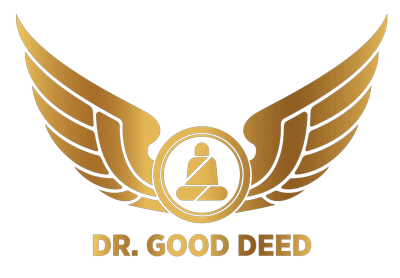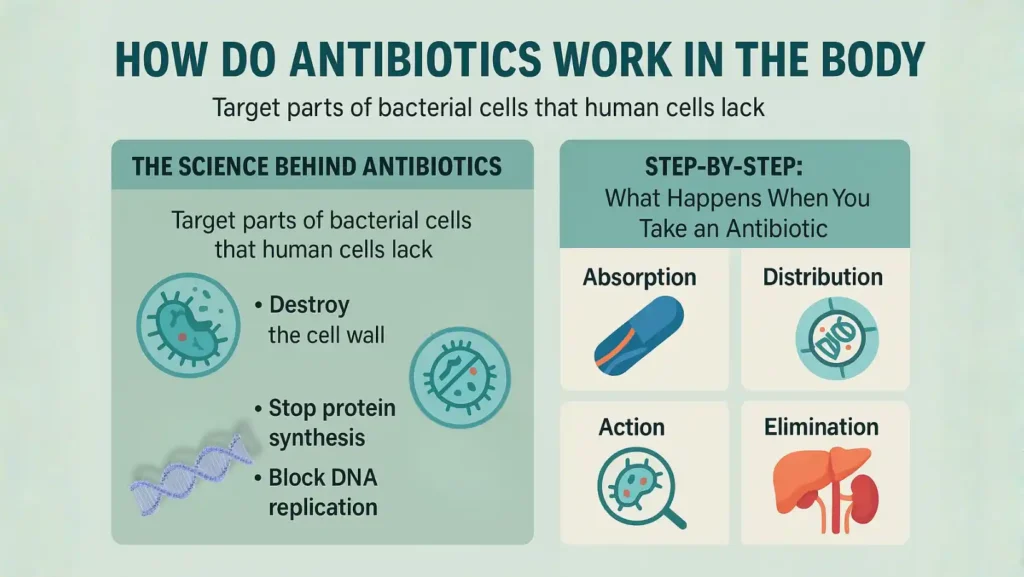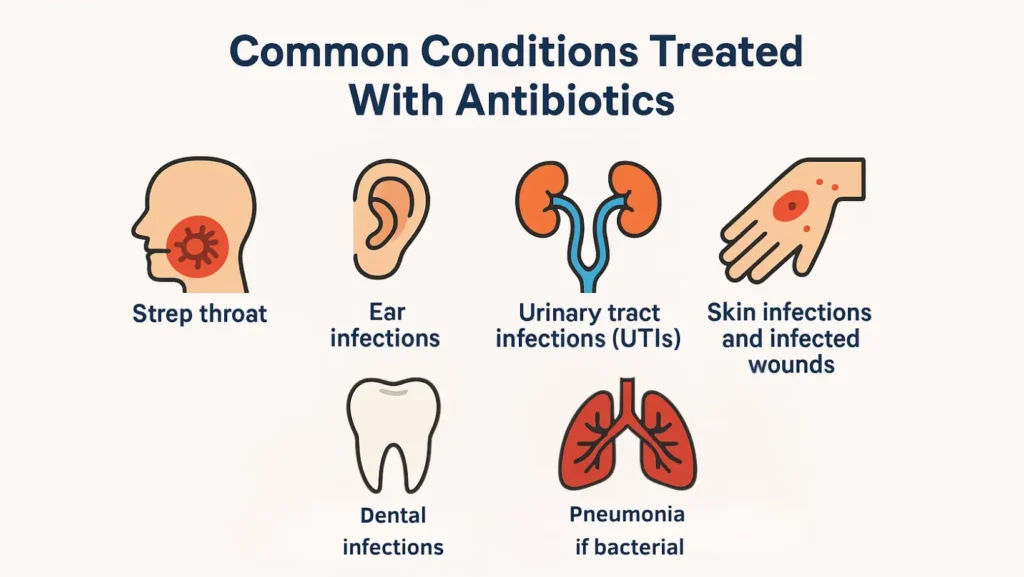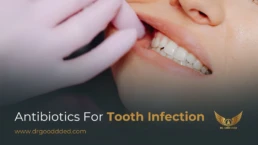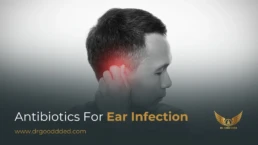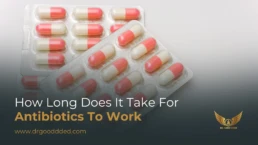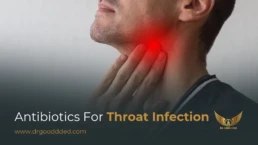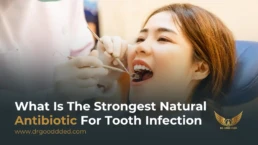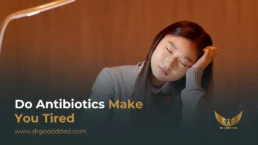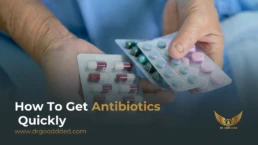Antibiotics are medicines made to fight bacterial infections. Antibiotics work by either killing bacteria or stopping them from growing. They don’t affect viruses, fungi, or parasites, which is why they’re not useful for things like the common cold or flu.
Table of Contents
ToggleWhat Antibiotics Are and How They Were Discovered
Antibiotics are chemical substances that stop harmful bacteria from multiplying or kill them outright. The story of antibiotics began in 1928 when Alexander Fleming noticed that a mold called Penicillium stopped bacteria from growing on a petri dish. This discovery led to penicillin, the first true antibiotic.
Before antibiotics, even a small wound or sore throat could become deadly. When penicillin came along, it changed medicine forever. Today, doctors have hundreds of antibiotics that treat everything from skin infections to pneumonia.
The Difference Between Antibiotics and Other Medicines
Antibiotics only fight bacteria. Painkillers reduce pain, antivirals fight viruses, antifungals treat fungal infections, and vaccines prevent diseases before they start. Mixing these up can cause problems.
For example, taking antibiotics for the flu won’t help you recover faster. In fact, it might harm your good bacteria and make you feel worse. So, understanding how antibiotics work helps you use them properly.
How Do Antibiotics Work in the Body?
The Science Behind Antibiotics
The science behind antibiotics is simple but powerful. Antibiotics work by targeting parts of bacterial cells that human cells don’t have. This makes them safe for your body.
Here’s how how do antibiotics work in more detail:
- Some antibiotics, like penicillin, destroy the bacteria’s cell wall. Without that wall, the bacteria burst and die.
- Others, such as tetracyclines, stop bacteria from making proteins they need to survive.
- Some, like fluoroquinolones, stop DNA from copying itself, preventing the bacteria from multiplying.
Antibiotics are designed to attack bacteria while leaving your body’s own cells unharmed. That’s why they’re effective but only when used correctly.
Step-by-Step: What Happens When You Take an Antibiotic
- Absorption: After swallowing the pill, the antibiotic moves into your bloodstream.
- Distribution: The drug travels to the infected part of your body.
- Action: It locks onto bacteria and starts killing them or stopping their growth.
- Elimination: The body removes the medicine through the liver or kidneys.
Some antibiotics start acting within hours. If you’re wondering how fast antibiotics work, most people notice an improvement in 1 to 3 days.
Types of Antibiotics and Their Mechanisms
Antibiotics fall into several categories based on how they work. The main types are shown below:
| Type | Description | Example | Mechanism |
| Bactericidal | Kill bacteria directly | Penicillin, Cephalosporins | Break the bacterial cell wall |
| Bacteriostatic | Stop bacteria from multiplying | Tetracyclines, Macrolides | Block protein production |
| Broad-Spectrum | Target many bacterial types | Amoxicillin, Ciprofloxacin | Useful when the infection source is unknown |
| Narrow-Spectrum | Target specific bacteria | Azithromycin, Vancomycin | Lower risk of harming good bacteria |
Bactericidal drugs destroy bacteria completely, while bacteriostatic ones pause their growth, letting your immune system clear them.
How Antibiotics Target Bacteria Specifically
The Difference Between Human and Bacterial Cells
Your body’s cells and bacterial cells are built differently. Human cells don’t have cell walls, while bacteria do. Antibiotics take advantage of this difference.
For instance, penicillin weakens the bacterial cell wall so it breaks apart. Other antibiotics attack bacterial ribosomes (protein-building parts) without touching human ones. That’s how antibiotics work without harming your own body cells.
Common Antibiotic Targets
Antibiotics attack different parts of the bacterial structure:
- Cell Wall: Penicillin and related drugs damage it, making the bacteria burst.
- Protein Synthesis: Drugs like erythromycin stop bacteria from building proteins.
- DNA Replication: Fluoroquinolones prevent bacteria from copying DNA.
- Cell Membrane: Polymyxins poke holes in bacterial membranes, killing them fast.
What Antibiotics Do Not Work Against
Antibiotics and Viral Infections
Antibiotics can’t fight viruses. The flu, colds, and most sore throats are viral. Taking antibiotics for these illnesses doesn’t help you recover faster and may lead to resistance.
Fungal and Parasitic Infections
Fungi and parasites are completely different from bacteria. Antifungal and antiparasitic drugs are used for those infections instead. Antibiotics do not work on them at all.
Dangers of Misusing Antibiotics for Wrong Illnesses
Taking antibiotics when you don’t need them can harm your body. It can destroy good gut bacteria, cause diarrhea, and even make bacteria resistant. Resistance means the medicine won’t work next time you really need it.
Common Conditions Treated With Antibiotics
Bacterial Infections That Commonly Require Antibiotics
Antibiotics treat infections like:
- Strep throat (caused by Streptococcus bacteria)
- Ear infections
- Urinary tract infections (UTIs)
- Skin infections and infected wounds
- Antibiotics for tooth infection
- Pneumonia (if bacterial)
For a urinary tract infection, most people feel better in 24 to 48 hours after taking antibiotics, though you should always complete the full course.
When Doctors Avoid Prescribing Antibiotics
Doctors don’t prescribe antibiotics for mild colds, coughs, or viral infections. They also avoid them for illnesses that heal on their own. This careful approach prevents misuse and keeps antibiotics effective for the future.
How To Take Antibiotics Safely
Always Follow a Doctor’s Prescription
Only take antibiotics if prescribed. Never share them or save leftovers. The right type, dose, and duration depend on your condition.
Importance of Completing the Full Course
Even when you start feeling better, finish your medicine. If you stop early, some bacteria may survive and become resistant. This is a key reason for rising antibiotic resistance worldwide.
Avoid Alcohol and Drug Interactions
Alcohol can reduce antibiotic effectiveness and worsen side effects. Some antibiotics react badly with alcohol or other drugs, so always ask your doctor before combining them.
How To Store and Dispose of Antibiotics Properly
Keep antibiotics in a cool, dry place. Never use expired ones. Dispose of unused drugs safely; pharmacies can help with proper disposal.
Possible Side Effects and Precautions
Common Side Effects
Antibiotics can make you tired and cause stomach upset, nausea, diarrhea, or a mild rash. These side effects are usually short-term and go away once the course ends.
Allergic Reactions and Warning Signs
Allergic reactions can be serious. Watch for itching, swelling, or trouble breathing. If these occur, stop taking the medicine and seek help immediately.
When To Contact a Doctor Immediately
Call your doctor if you have a high fever, severe diarrhea, or signs of an allergy. You should also reach out if symptoms don’t improve within three days.
FAQs
How Do Antibiotics Know Which Bacteria to Kill?
Antibiotics don’t “know,” but they work by targeting features unique to bacteria, like cell walls or ribosomes. That’s how antibiotics work without damaging your own body cells.
Why Don’t Antibiotics Work on Viruses?
Viruses hide inside your cells and use your cell parts to grow. Antibiotics only target bacterial parts, which is why they can’t stop viral infections like the flu or cold.
What Happens If I Stop Taking Antibiotics Too Early?
Stopping too soon allows bacteria to survive and become resistant. Always complete your full dose even when you feel better to make sure all bacteria are gone.
Can I Take Antibiotics for a Cold or Sore Throat?
Most colds and sore throats are caused by viruses, not bacteria. Taking antibiotics for these conditions will not help and may cause harmful side effects.
What’s the Difference Between Broad-Spectrum and Narrow-Spectrum Antibiotics?
Broad-spectrum drugs kill many bacterial types, while narrow-spectrum ones target specific bacteria. Doctors choose based on the infection type and cause.
How long do antibiotics take to work?
Most start easing symptoms within one to three days of taking antibiotics. If you don’t feel better after three days, see your doctor.
Are Natural Antibiotics Effective?
Some natural foods like honey and garlic have mild antibacterial effects, but they’re not strong enough to replace prescription antibiotics for serious infections.
Can Antibiotics Cause Side Effects or Allergies?
Yes, antibiotics can sometimes cause upset stomach or allergic reactions. Always tell your doctor about previous allergies before starting a new medication.
How Do Antibiotics Affect Gut Bacteria?
Antibiotics can kill both harmful and helpful gut bacteria. This can cause diarrhea. Eating yogurt or taking probiotics can help restore a healthy gut bacteria balance.
What Is Antibiotic Resistance and How Can We Prevent It?
Resistance happens when bacteria adapt and stop responding to antibiotics. Prevent it by finishing your full course and only using antibiotics when prescribed.

This article is medically reviewed by Dr. Nivedita Pandey, Senior Gastroenterologist and Hepatologist, ensuring accurate and reliable health information.
Dr. Nivedita Pandey is a U.S.-trained gastroenterologist specializing in pre and post-liver transplant care, as well as managing chronic gastrointestinal disorders. Known for her compassionate and patient-centered approach, Dr. Pandey is dedicated to delivering the highest quality of care to each patient.
